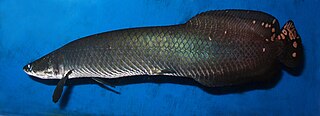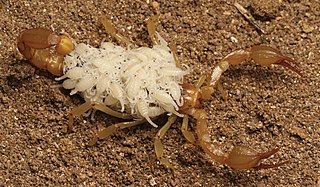
Sentience is the ability to experience feelings and sensations. The word was first coined by philosophers in the 1630s for the concept of an ability to feel, derived from Latin sentiens (feeling), to distinguish it from the ability to think (reason). In modern Western philosophy, sentience is the ability to experience sensations. In different Asian religions, the word "sentience" has been used to translate a variety of concepts. In science fiction, the word "sentience" is sometimes used interchangeably with "sapience", "self-awareness", or "consciousness".
Social science fiction is a subgenre of science fiction, usually soft science fiction, concerned less with technology/space opera and more with speculation about society. In other words, it "absorbs and discusses anthropology" and speculates about human behavior and interactions.
Woodwardopterus is a genus of prehistoric eurypterid, or sea scorpion, classified as part of the family Mycteroptidae.
Charles Noyes Forbes (1883–1920) was an American botanist who primarily worked on Hawaii.

Chondrocladia lyra, also known as the lyre sponge or harp sponge, is a species of carnivorous deep-sea sponge first discovered off the Californian coast living at depths of 10,800–11,500 feet (3,300–3,500 m) by Welton L. Lee, Henry M Reiswig, William C. Austin, and Lonny Lundsten from the Monterey Bay Aquarium Research Institute (MBARI).

Gondwanascorpio emzantsiensis is an extinct Gondwanan scorpion that lived 360 million years ago in the Devonian. Its fossil remains, clearly showing pincer and sting, were discovered in rocks of the Witteberg Group near Grahamstown in South Africa. At present, this scorpion is the oldest known land-dwelling animal from Gondwana, which in Devonian times was separated from Laurasia by a deep ocean. At the time, the fossil site was only 15° from the South Pole, but rather than arctic-like tundra, the region was probably wooded, providing ample insect life for food. Previously, only two scorpion species were known from the late Devonian – Hubeiscorpio gracilitarsus from China and Petaloscorpio bureaui from Canada. The species was described by Robert Gess of Wits University in the journal African Invertebrates. The specific epithet derives from umZantsi, the isiXhosa word for "south", sometimes used for South Africa.

Arapaima leptosoma is a species of freshwater fish endemic to Brazil. It is a member of the arapaimas, a genus of air-breathing fish that contains some of the world's largest freshwater fish. Like other members of the genus Arapaima, this fish can breathe air. It is known only from the confluence of the Solimões and Purus Rivers in Amazonas, Brazil, although due to the lack of obvious geographic barriers, it likely has a larger range.

Bush Blitz is a species discovery program conducting scientific surveys in Australian terrestrial and marine environments to document known and new fungi, plants and animals. The program is a partnership between the Australian Government, BHP Sustainable Communities and Earthwatch Australia. Bush Blitz is managed through Parks Australia and the Australian Biological Resources Study. The program began in 2010, the International Year of Biodiversity, involving specialist taxonomists, indigenous communities, rangers and landowners, teachers, students and BHP employees. Bush Blitz funds taxonomy and further research based on material collected during Bush Blitz surveys, specifically targeted to assist in the publication of new species and the resolution of problematic groups collected from surveys.

HD 131399 is a star system in the constellation of Centaurus. Based on the system's electromagnetic spectrum, it is located around 351 light-years away. The total apparent magnitude is 7.07, but because of interstellar dust between it and the Earth, it appears 0.22 ± 0.09 magnitudes dimmer than it should be.

Paruroctonus is a genus of scorpions in the family Vaejovidae. There are about 10 described species in Paruroctonus.

Lauren Esposito is the assistant curator and Schlinger chair of Arachnology at the California Academy of Sciences. She is the co-founder of the network 500 Queer Scientists.

Parioscorpio is an extinct genus of arthropod containing the species P. venator known from the Silurian-aged Waukesha Biota of the Brandon Bridge Formation near Waukesha, Wisconsin. This animal has gone through a confusing taxonomic history, being called an arachnid, crustacean, and an artiopodan arthropod at various points. This animal is one of the more famous fossil finds from Wisconsin, due to the media coverage it received based on its original description in 2020 as a basal scorpion.

Paralitherizinosaurus is an extinct genus of therizinosaurid dinosaur from the Late Cretaceous Osoushinai Formation of Hokkaido, Japan. The genus contains a single species, P. japonicus, known from a partial right hand and cervical vertebra. Paralitherizinosaurus represents the youngest therizinosaur known from Japan.

Cirrhilabrus finifenmaa, also known by its common name rose-veiled fairy wrasse, is a rainbow-colored wrasse that is native to the reefs of the Maldives.

Paruroctonus soda is a species of scorpion in the genus Paruroctonus. It lives in the deserts of Southern California where it is found in dry lake beds and playas of Soda Lake and Koehn Lake. P. soda is an alkali sink specialist species.

Scolopendra alcyona, known in Japanese as 琉神大百足 and in English as the Halcyon giant centipede, is a species of amphibious centipede found in the Ryukyu Archipelago of Japan and Taiwan. It is the third amphibious member of the genus Scolopendra discovered so far, and the largest species of centipede in Japan, as well as the first new centipede species discovered in Japan for 143 years.

Wernerius inyoensis is a species of scorpion in the taxomic family Vaejovidae. W. inyoensis is the third species described in the genus Wernerius. Wernerius inyoensis lives throughout the Inyo Mountains of Death Valley National Park in the southwestern North America, eastern California just like many scorpion species discovered around the year 2009.
The slender bleating tree frog, is a frog in the family Hylidae. It is endemic to Australia, where it is found in Queensland and the Bunya Mountains. This is the "bleating tree frog" that occurs around Brisbane.
The southern stuttering frog is a large species of frog endemic to south-eastern Australia. It is found in mid-eastern New South Wales and at least formerly Victoria, where it ranges from Carrai National Park south to East Gippsland. It inhabits temperate and subtropical rainforest, wet sclerophyll forest, and moist gullies in dry forests.













